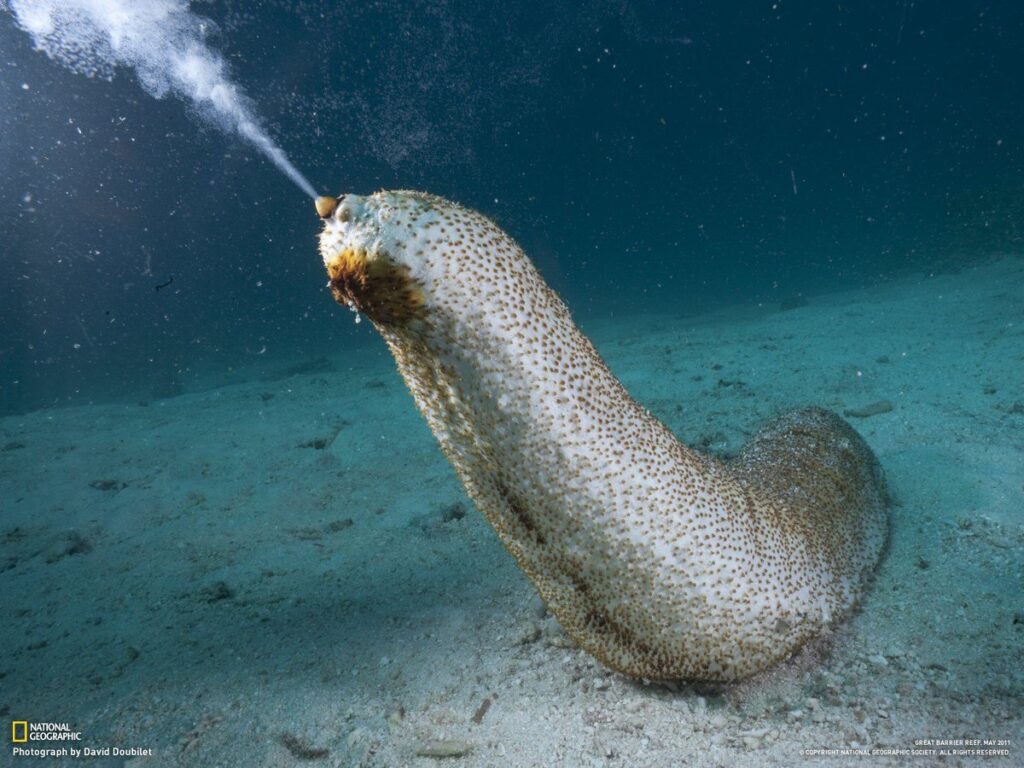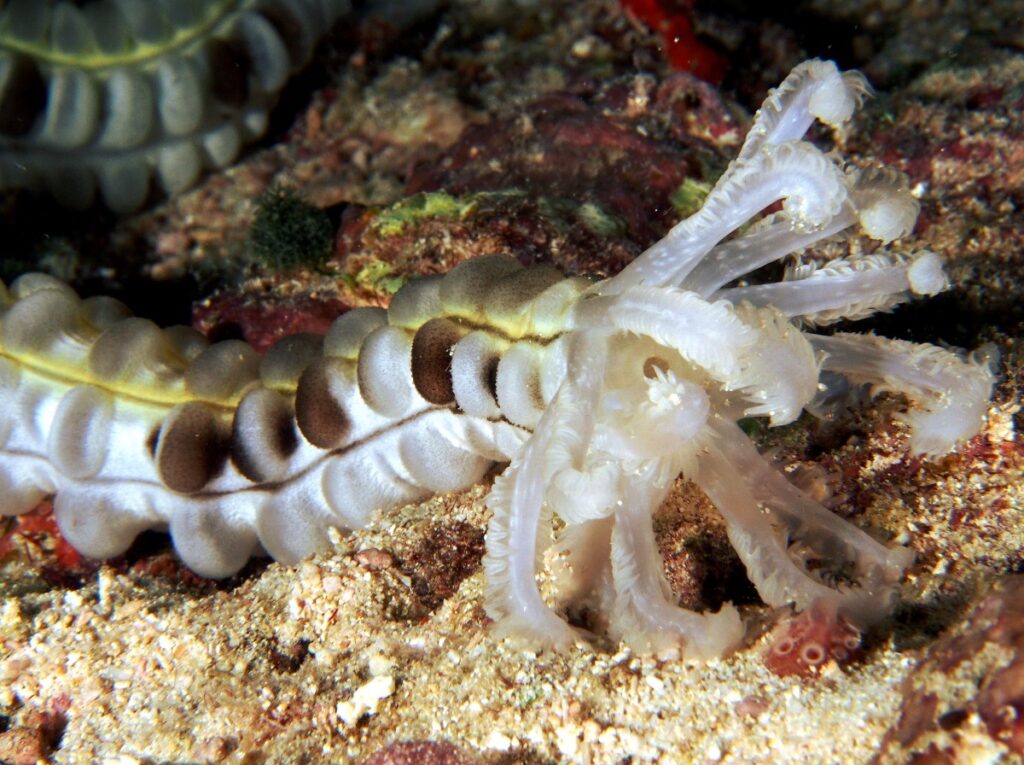Safeguarding Sea Cucumbers
Laurie King
Have you ever eaten sea cucumbers? Sea cucumbers are a luxury seafood item, but consumerism is killing them and safeguarding sea cucumbers is becoming increasingly important. People’s greater affluence has led to an increase in demand, but our big appetite for beche-de-mer (gutted and dried sea cucumbers) is not sustainable.
Sea cucumbers are also used in cosmetics; their body walls are 70% collagen and bioscience companies are incorporating them into their skincare lines. They are also used in integrative medicine. According to Memorial Sloan Kettering Cancer Center, sea cucumbers contain chondroitin sulfate, which may help treat osteoarthritis, and a saponin compound, which may have antitumor properties.
Sea cucumbers are part of an animal group called echinoderms. They get their name because their body is shaped like a cucumber, but they have small tentacle-like tube feet that are used for locomotion and feeding. They range in size from one inch to six feet.

Three species of sea cucumbers are threatened by international trade for commercial use as food, medicine and cosmetics. But losing these species would have broad repercussions for the ocean as a whole. Sea cucumbers are bioturbators—they burrow, eat and excrete ocean floor sediment—thereby recycling nutrients in the ecosystem. By bioturbating, sea cucumbers add alkalinity to the ocean water and offset ocean acidification, aiding the health of coral reefs and lagoons. And a diverse range of predators depend on them for food, including 19 species of seastars, 17 crustaceans, several gastropods and about 30 species of fish.
To help ensure healthy populations of sea cucumbers as well as viable fisheries, the 184 governments that are Parties to the Convention on International Trade in Endangered Species (CITES) are considering a proposal to regulate trade of some of these species.
The Evidence
Statistics are sparse but show a substantial decline in the populations of these species. Below is the recap from the CITES Secretariat’s recommendation summarizing population data for the genus Thelenota. It can be found at cites.org in the COP19 pages.
T. ananas: In New Caledonia (France), the species has declined more than 60% over the past 30 years, with 10-30 individuals/ha being found in the 1980s to 6 individuals/ha in 2009. Similarly, the proponents report that in Tonga the occurrence declined from 48 in 1984 (from 1 hour search period at 21 sites) to 4 in 2004 (100 m transects, after a fishing moratorium) and in French Polynesia it was reported to be present “but in low numbers” following the lifting of a sea cucumber fishing moratorium. The proponents report that the species is considered overexploited with severely depleted populations throughout much of its range and provides references that show that the catch per unit effort and size of specimens have declined in India and that the species is heavily depleted in Indonesia. The support statement also provides evidence of decline in the Red Sea, which shows a decline from 48.1 individual/100m2 in 2000 to 56 individuals/100m2 in 2006, but no individuals being recorded in 2016. In 2013, the IUCN Red List of Threatened Species concluded that the species has declined 80-90% in at least 50% of its range and overexploited in at least 30% of its range.
T. anax: According to the supporting statement, this species is naturally relatively uncommon and generally found at low densities but is being increasingly targeted as other species decline. The proponents report that in Papua New Guinea the species’ density decreased from 1 to 0.7 individuals/ha from 1992 to 2006 and in Malaysia there is a decrease in population and average size of the species. In Tonga, occurrences varied over a 20-year period, which includes a fishing moratorium with 48 occurrences in 1984 (1 h search period at 21 sites) during inactive fisheries, to 21 in 1996 with an active fishery to 41 in 2004 (100 m transects) 7 years after a fishing moratorium. The proponents cite a study conducted in Samoa that did not find any records whereas in Guam the species was found in only one site out of 74. Based on the information provided, it can be inferred that the species is very rare and occurs at very low density.
T. rubralineata: The supporting statements reports that this species is rare and not often recorded in surveys. The proponents report that where found, the recorded density is 1 individual/220m2 to less than 1 individual/ha (Indonesia), less than 0.1 individual/ha and only 4 specimens were found in 1000 survey dives (Papua New Guinea). The highest density is reported to be 45 individuals/ha in the Solomon Islands. While the information in the supporting statement shows that the species is rare, population decline cannot be quantified or inferred based on the information.
The biggest risk factor for sea cucumber populations is their high value. A 2018 survey of retail market prices in Hong Kong and Guangzhou, China showed average prices for high-value species ranged up to $369.00 per kilogram and were as much as $1,898.00 per kilogram for exceptional quality products. In addition to being extremely lucrative, sea cucumbers are relatively easy to catch because they are largely found in shallow reef areas and are slow moving.
A number of nations have regulated trade within their jurisdiction in an effort to protect the species and return fisheries to healthy population levels. Common responses to depleted fisheries have been to close fishing areas or set minimum size limits for harvesting sea cucumbers. But these species remain extremely vulnerable without comprehensive, global action.
Proposal for Potential Solutions
The official proposal being considered at the Conference of the Parties 19 is to include the genus Thelenota in Appendix II, which would mean that international trade is regulated and needs to show evidence that it is sustainable. Practically speaking, this designation allows regulated trade to continue, supporting the interests of fishermen, exporters and importers, while also preserving these species.
The preliminary assessment by the Secretariat of CITES is recommending that T. ananas and T. anax be included in Appendix II.
No international regulations legally protect species within Thelenota, which is why adoption at COP19 of Proposal 42 would be a large step forward to globally protect high-value sea cucumbers going forward.

What Sea Save Foundation Is Doing
We are working with delegates at this year’s conference to enact changes to international trade of endangered species that will protect them globally. We do this by offering creative, economically viable, sustainable and environmentally friendly plans to decision-makers. We recognize this challenge is not only to protect wildlife, but to ensure the economic livelihood and food security of people.
We are credible, scientific and connected. We’ve sent three delegates to this year’s conference, including our director, Georgienne Bradley, who recently earned a master’s degree in the Management and Conservation of Species in Trade. To date, only a select number of students have completed this specialized training in scientific bases, technique and instruments that enable CITES implementation and development to combat illegal international trade of wildlife.




